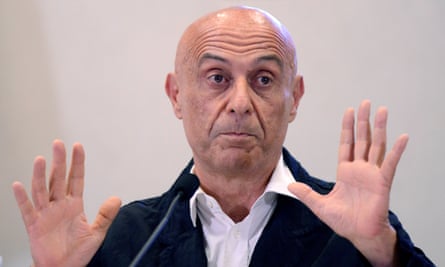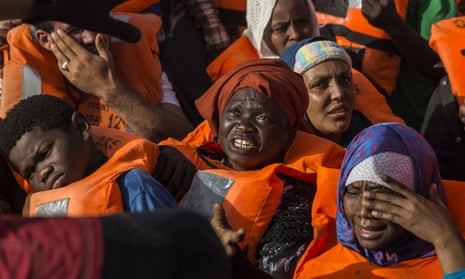Over the last decade, migration has become an urgent political issue. The 2010s have been marked not only by the global movement of people across national borders but also attempts by governments to erect walls and fences in their path. We’ve seen nationalism winning votes and the worldview of the far right mainstreamed.
“Flow”, “flood” and “crisis”. Media imagery and language has shaped public opinion. Of course, migration from the global south to the north – intimately connected to the legacy of colonialism and the west’s military machinations – has been happening for decades. But the 2010s has seen a higher number of people from the south moving towards the north. In particular, Europe has seen hundreds of thousands of people from Africa, the Middle East and south Asia, fleeing chronic poverty, political instability, wars, and the climate crisis in countries often laid to ruin by western-backed institutions.
Libya had always been the migratory destination for many sub-Saharan Africans because of its employment opportunities. Following the suppression of the 2011 Arab spring and Nato’s intervention in Libya, a lawless society emerged, with racial hatred against sub-Saharan Africans unleashed. Many escaped forced labour and torture, climbed into dinghies and began the dangerous sea journey across the central Mediterranean. But when they landed in Europe, they didn’t come to safety. Instead, they found themselves in the centre of a white, Eurocentric discourse – a “problem” to be blamed for society’s ills.
Throughout this time, when tens of thousands died at sea trying to reach Europe, Europe has imagined itself to be the victim of a migrant or refugee “crisis”. The concept of a “crisis” caused by the movement of people into the European continent has always been embedded in the Eurocentric way of seeing things. This rupture brought about by the arrival of the “other” creates anxiety and fear in the European mind, as the sociologist Encarnación Gutiérrez Rodríguez has pointed out – thus the need to create neverending irrational, ideological justifications for that anxiety and fear.

This can be seen in the way migration into Europe has been portrayed as an “invasion” of different cultures and a “clash of civilisations” – in a way that is similar to the justifications of the colonial era where the colonised were cast as racially inferior beings. Colonialism still casts its shadow over the immigration debate. For Europe, the “other” challenges its “way of being” as its presence is a reflection of Europe’s past imperialism, upon which much of the continent’s wealth was built.
In the past decade, we’ve seen anti-migrant policies and racism flourish across the world. The EU implemented the hotspot system, filtering people and categorising them as asylum seekers or “economic migrants”. Europe’s patrolling of its southern borders intensified, resulting in deals with Turkey and Libya. Since Italy’s then-interior minister Marco Minniti’s agreement with Libya in 2017, Italy has supplied technical support to the Libyan coastguard, fending Africans away from European waters.
Restrictions were also imposed on NGO search-and-rescue activity in the Mediterranean. These policies under the centre-left Democratic party (PD) were later continued and elaborated on by the hard-right Matteo Salvini of the League from the summer of 2018 – and now carry on under the PD/Five Star coalition. Thousands have died as a result.
Back in the 1970s, the critic and writer John Berger depicted Turkish migration to Germany in A Seventh Man, which charted migrant workers’ journeys in Europe through their departure, work and return. The “return” represented the future, where a worker could travel freely and see lives improved for his family when he visited home. But in the 2010s, this cycle has been disrupted – many migrants’ and asylum seekers’ irregular status prevent them from visiting home. Instead, they are forced to live invisible lives, illegalised, entrapped and segregated.
In Britain, the Conservative government has persistently refused to receive refugees – only 3% of asylum applications in Europe are lodged in Britain because refugees are commonly denied entry. In 2016, when the refugee numbers were at their highest across the continent, Britain only received 38,517 applications for asylum, compared with 722,370 applications in Germany, 123,432 in Italy and 85,244 in France. Britain, simply put, has one of the lowest refugee acceptance rates in Europe.
Plenty of efforts have also been made – see the Home Office’s “hostile environment” – to make life unbearable for asylum seekers and migrants in Britain. Over the decade, I have witnessed asylum seekers leading a subhuman existence, deprived of rights to work (despite the substandard state support) and made to pay for healthcare. They live in desperate limbo, pushed into the world of exploitation and forced labour. As a Chinese builder said to me: “If you didn’t die in the back of a lorry, you could die working here.”
And there are many migrants who are effectively imprisoned. Throughout this decade, I have visited many people detained in Dover and Yarl’s Wood removal centres, held without time limit, and despite committing no crime. Today, Britain remains the only European country to practice the indefinite detention of asylum seekers and migrants. Over this Christmas, 1,826 people were incarcerated in these centres.
While large numbers of people across the globe continue to be denied freedom of movement and illegalised, their determination to survive will not be defeated by walls and borders. Migrant protest movements such as the black vests (gilets noirs) in France and the black sardines (sardine nere) in Italy show that there is plenty of resolve and a willingness to fight back. We can join them by fighting for the regularisation of people’s immigration status – but also by challenging the system that enables their marginalisation and racial segregation. We must offer a different way of seeing migration; a real alternative that addresses colonialism and the massively unequal world that it has created.
